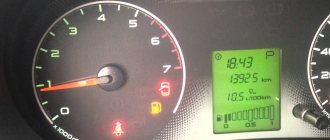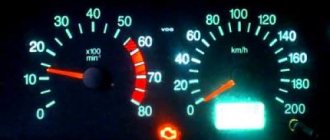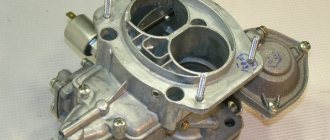Drivers’ complaints that whenever the engine heats up, strange things begin to happen with the speed (the so-called “floating effect”), it is not so rare to hear. This unpleasant incident is inherent in gasoline engines that have injection, carburetor formats, as well as engines running on diesel fuel. If, when the engine warms up, the speed suddenly slows down, this is a sure signal that something unexpected has happened to it and you need to immediately look for the cause and fix the problem.
Eliminating the problem of floating engine speed.
The reason for the appearance of floating speed
If the speed fluctuates on a warm engine under load or in idle mode, you should immediately carry out a comprehensive diagnosis of the car so as not to aggravate the situation. But at the initial stage of the study, it is advisable to understand the peculiarities of the floating speed. An ordinary tachometer will help to record this. If everything is fine with the engine, the tachometer will record stable readings at approximately the same level (about 800 rpm), without sudden jumps. However, if something is wrong with the engine, the range of tachometer readings will rapidly increase, ranging from 500 to 1500 revolutions per minute.
The presence of floating speed is also proven by the amount of engine rumble, which from time to time either increases or decreases. In addition, vibrations of varying strengths that change like a sine wave begin to be clearly felt inside the car from the engine. Such incidents are most often recorded during unstable engine speeds, which operate in idle mode.
However, tachometer “jumps” are sometimes observed during intermediate engine speeds, which is typical for diesel engines. If there are deviations from the norm, the tachometer may show a completely unimaginable speed range. For example, from 500 to 1000, and then to 1500 rpm, after which they rapidly fall, in the reverse order, to 500 rpm. This is clearly noticeable when the load on the engine increases:
- after pressing the brake pedal;
- rotation of a steering wheel equipped with a hydraulic booster;
- turning on the air conditioner;
- when driving transitional type and so on.
In such cases, the engine at idle, in the absence of excess load, manages to keep the speed stable, but as soon as it appears, the speed immediately drops and the engine almost stalls. Additional “noises” include an unreasonable increase in fuel consumption and other factors.
Why do the revs fluctuate when cold?
Common causes of jumping revolutions
First, let's look at the main causes of this malfunction for injection engines, since most often this is where this problem occurs. In addition, most of the faults listed below will occur on engines of any type of fuel supply.
Atmospheric air suction
Air intake in the intake manifold can cause the speed to fluctuate both “cold” and “hot”. Air can enter the engine not only directly through the intake manifold, but also through cracks in the elements of the air system. For example, through the walls of the manifold (very important for manifolds with a plastic body), leaking vacuum hoses, places where hoses or pipes are connected. It often sucks air in the place where the throttle valve meets the manifold.
Since the question is why a cold engine does not maintain speed, but when warmed up everything returns to normal, then in this case it is worth remembering ordinary physics. It’s just that as it warms up, all the elements under the hood warm up, which is why their bodies expand and air, if at all, is sucked in, then to a lesser extent. Consequently, the speed levels out and no longer fluctuates.
Typical parts in the intake tract through which air leaks usually occur:
- Intake manifold gasket. Like most gaskets, it hardens and dries over time. Accordingly, air begins to penetrate through the manifold, which is not taken into account by sensors (in particular, mass air flow sensor, DBP and others). Due to excess air in the system, the engine begins to “suffocate” and eventually stalls.
- Gasket on the throttle valve. The throttle valve itself is designed to control the amount of air entering the engine. Therefore, if it allows excess air to pass through (in particular, through the gasket), the engine will also experience a loss of power.
- Pipe from the air filter to the throttle body. The situation is similar here. The volume of incoming air is clearly controlled by sensors. If excess air enters, the engine speed will “float”.
- O-ring of injectors. On injectors that have been in use for a long time, the O-rings become unusable over time. Accordingly, unaccounted air, which is superfluous, enters the combustion chamber through them. This leads to a drop in engine power and to the fact that the speed fluctuates when cold. When the injector rings themselves and the engine are cold, they are smaller in diameter, and then, as they warm up, the rings soften and acquire a normal diameter, so the speed stabilizes.
- Vacuum brake booster. In this case, depressurization of both the VUT itself and its hose with a vacuum valve, which communicates with the intake manifold, is possible.
- Vacuum hoses in the air duct system. Depending on the design of a particular engine, the number, size and location of hoses will vary. However, in any case, since vacuum hoses are designed to transmit vacuum, the entry of air into them will have an incorrect effect on the operation of the engine as a whole.
- Canister valve. The solenoid valve of the adsorber is designed to purge it. The valve is controlled by an electronic control unit based on information from a large number of sensors, which can also be the “culprit” of the breakdown. However, in any case, when the adsorber valve exits, a situation arises when the adsorber is not purged and a “clog” occurs in the system.
- Idle speed regulator. This unit is designed to maintain idle speed with the throttle valve fully closed (via the bypass). If it fails, then when the throttle is closed the engine will simply stall. If the regulator is unstable, then the engine speed will “float”.
In carburetor cars, air leaks may still occur in the following places:
- Fuel mixture adjustment bolt. If it is damaged or incorrectly configured, it is possible that when the engine is cold, an air-fuel mixture with suboptimal parameters will form in the carburetor.
- Gasket under the carburetor. If it is damaged or simply aged, it can allow external air to pass through it, which will also result in the formation of an air-fuel mixture that is unsuitable for “cold” mode.
- The throttle valve, if it does not fit tightly into its seat. If on injection engines the damper is driven by servo drives, then on carburetor cars the damper is usually driven mechanically - through a metal cable. Therefore, the cause of a loose fit can be either a dirty valve or problems with the cable. For example, its contamination, damage to the shirt, the appearance of dirt or rust on it.
- Throttle axles. If they are dirty or damaged, the normal operation of the throttle is disrupted. Accordingly, idle speed failure is possible in various engine operating modes, including cold.
- Throttle damper diaphragm. Its task is to deplete the air-fuel mixture to optimal levels. If it is damaged (cracks, aging), air may leak. The result will be similar - unstable speed in different engine operating modes.
- Solenoid valve. Its main task is to reduce engine fuel consumption. This is achieved by the valve closing the channel through which the air-fuel mixture is supplied. If the valve is completely faulty, then its needle will completely block this channel and the engine will simply stall. If the solenoid valve is only partially out of order, then the engine speed, including when cold, will be unstable.
Low fuel pressure
For the same common reason as air leaks, the engine does not idle when cold due to low pressure in the fuel system. In turn, this may be caused by the following reasons:
- Dirty fuel filter. Moreover, both the main fuel filter and the mesh on the fuel pump of injection machines can be contaminated. Dirt in the filter does not allow fuel to pass through, which causes “starvation” and unstable speed in different engine operating modes.
- Fuel regulator. If it fails completely, the engine will most likely stall completely. If it is partially broken, then the speed will “float”, including when it is cold.
- Gasoline pump. This applies to both carburetor and injection engines. In the first case, the problems will only be of a mechanical nature. In injection fuel pumps, the blades may wear out, the bearings may fail, and the electrical wiring may be damaged.
- Low compression. It is also possible to have different compression for different cylinders. This is especially felt in the cold, when in the cold the cylinders slightly decrease in size, and after warming up they increase, and accordingly, the compression increases.
- Uneven fuel supply to the cylinders. There are various possible reasons for this. Starting from dirty injectors and ending with a failure in the ignition system. For example, misfires may occur.
- Mismatch between injection timing and spark supply. As a rule, the cause of this is the crankshaft position sensor. However, the idle speed will be unstable not only when cold, but also in other engine operating modes.
Idle speed control
If it partially fails or becomes dirty, it may jam and, after starting the engine, not immediately set the required speed values. IAC jamming is possible in both cold and warm weather.
In general, the idle air control is designed to adjust (increase or decrease) the supply of fuel to the combustion chamber. The device operates on the basis of a needle and a rod. It turns on when the engine is idling, that is, at low speeds. One of the signs of a malfunctioning idle speed control is the fact that the engine may run normally under load, but stall at idle. Likewise, the driver is forced to apply gas while starting the engine. If the IAC is faulty, the idle speed may change as the load on the engine (battery) increases. In particular, when turning on external lighting, air conditioning, climate control systems and other consumers.
Engine sensors
A modern injection engine is equipped with a large number of sensors, and accordingly, if many of them fail, it can lead to a problem like idle speed floating on a cold engine. According to practice, the “culprits” for such a situation are most often:
- throttle position sensor (TPS);
- mass air flow sensor (MAF);
- absolute air pressure sensor (DAP);
- manifold inlet air temperature sensor (DTVV);
- engine temperature sensor.
The sensors listed above in some cases (in case of complete or partial failure, for example, as a result of aging/wear) under critical operating conditions may provide incorrect data to the electronic engine control unit. And accordingly, the ECU will issue signals due to which the revolutions fluctuate greatly when cold. Moreover, both damage and ordinary contamination may occur.
If the temperature sensor is damaged, often after the first attempt to start the engine, it stalls if you do not pick up the speed with the accelerator pedal. After the second start, the engine usually works normally, but the speed fluctuates. They then drop from 1000 rpm to approximately 700...800 rpm, after which they “jump” above a thousand and fall again. This can continue until the engine is more or less warmed up.
This happens because if the electronic control unit “sees” that incorrect information is being received from the sensor or that the signal is not being received at all, then its algorithm is designed in such a way as to go into emergency mode. In this case, instead of a signal from the sensor, the ECU takes averaged data for calculations, and at the same time generates an error in memory. For example, if the engine temperature sensor fails, then instead of the data from it, the ambient air temperature will be taken into account. Accordingly, until the engine warms up, the speed will “float”. Moreover, the colder it is outside, the greater the spread and unpredictability of the speed.
Accumulator battery
On some cars, the problem that the speed fluctuates when cold is a weak battery charge. That is, the battery initially has enough charge to start the engine, but then its capacity drops significantly, and the energy is not enough to normally power other consumers.
One such example is a situation where, due to low voltage in the vehicle’s on-board network, the throttle settings are reset. Accordingly, the sensor provides incorrect information to the ECU, and the speed fluctuates. As the engine warms up, the battery is recharged and on most cars, the throttle valve self-learns (that is, self-tuning). Thus, after some time after starting, the speed stops jumping and stabilizes. Accordingly, in order to avoid such problems, it is necessary not only to regularly recharge the battery (especially in winter), but also to monitor its condition and, if necessary, buy a new battery.
In some cases, it is noted that the problem with floating speed, including when it is cold, disappears after replacing the battery with a new one. During the replacement process, errors in the ECU memory are cleared, that is, it is rebooted. And floating speeds can be the result of these errors. The errors themselves are most often associated with incorrect operation of the sensors (or failure).
There are known cases when the speed fluctuated, when the battery was not only undercharged, but also when the level of electrolyte in it was low, the terminals were oxidized, or there were other breakdowns in it. Please note that battery-induced floating will be more likely on vehicles equipped with a lot of additional electrical equipment, such as electric power steering, lots of additional lighting, a powerful audio system, and so on.
Oxygen sensor
In cars with an electronic engine management system, the design provides for the use of an oxygen sensor that analyzes the amount of CO2 and adjusts the fuel supply. However, this system only works when warmed up. Accordingly, after starting the engine, the ECU gives a signal to warm up the lambda sensor as quickly as possible by using more fuel and air. Accordingly, during the warm-up process, during the first few seconds (about 15...20 seconds), a situation is possible when the speed jumps to a cold one. As the engine warms up, engine performance stabilizes.
Wear of CPG parts
When starting a cold engine, for example in cold weather, a “diesel” effect can sometimes occur, which is why the engine and the car as a whole will vibrate strongly when cold. As it warms up, the corresponding vibration will pass.
In the cold, the metal parts of the cylinder-piston group slightly decrease in volume, which leads to a decrease in compression in the cylinders. That is, when starting the engine cold, there is more play between the parts, and as the engine warms up, they increase, compression increases, and the idle speed is leveled out.
Methods for solving the problem
Having detected a floating speed, experienced drivers begin checking the relevant electronics. During diagnostics, special attention is paid to the throttle assembly, as well as sensors and actuators. The operation of other mechanisms also needs to be diagnosed, including the ignition system and idle speed control, as well as air and fuel filters, injector nozzles, etc. There is especially a lot of hassle with the regulator and air flow sensor. Based on the results of a thorough diagnosis, it often turns out that the whole reason is a heavily contaminated throttle valve, which for this reason does not close as it should, or mechanical damage to the throttle. In the first case, careful cleaning of the valve immediately gives a positive result, but in the second case it is best to replace the throttle with a new one.
Tips and tricks
Let's look at how you can eliminate some of the malfunctions that lead to floating and speed jumps, and do it yourself.
- As mentioned above, the leakage of excess air can cause surges. To exclude or confirm the possibility of supplying such air, you need to check the tightness of the air supply system to the intake. You can remove the air hose and feed it air from a compressor or pump by placing the hose in a container of water. This method helps to identify cracks.
- As for the idle air control, you need to measure the resistance with a multimeter. If the resistance is between 40 and 80 ohms, this means that the device is not working.
- Also, as part of diagnostic procedures, in some cases it is necessary to clean the crankcase ventilation valve. The valve must be removed and washed with carburetor cleaning fluid or kerosene. This approach will remove deposits from the valve.
We also recommend reading the article about why the speed fluctuates on a cold engine. From this article you will learn about the reasons for jumps and floating speed on a cold engine, as well as ways to determine the cause and eliminate this malfunction.
- As for the ECM sensors, in this case it is not advisable to try to repair such elements. For example, if the mass air flow sensor is faulty, it is better to immediately replace it with a new one.
- It is better to trust specialists to flush the throttle valve without proper experience, especially if such flushing is necessary with the removal of the valve. If we talk about the method of flushing the throttle without removing it, you can do the procedure yourself. The hoses are disconnected from the valve, then a cleaning aerosol is injected into the throttle.
The main thing is to disconnect the electrical contacts from the throttle valve. Let us add that on many cars where the damper was heavily dirty, you then need to additionally set the correct opening gap of the damper or “teach” the throttle using the appropriate equipment.
- On a car with a carburetor, you need to adjust the idle speed by setting it with the quality and quantity screws on the carburetor. The idle jet may also need to be cleaned. To do this, it is often enough to inject a carburetor cleaning aerosol and then blow it with compressed air.
Let’s also add that to remove rust from the fuel injection pump, you can use special cleaners that are poured into the fuel tank. Also, some sources mention a method where a little motor oil is added to the fuel (about 200 ml per full tank).
According to drivers, this helps protect the pump from corrosion and is a preventative measure. At the same time, we note that this method is suitable for construction equipment and it is highly not recommended to practice such solutions on modern diesel internal combustion engines.
IAC sensor
The cause of engine operation deviation from normal parameters may also be a malfunction of the idle air control sensor (IAC). The whole point is that in cars, as a rule, it is not supplemented by a self-monitoring system, so on-board computers or check-angers do not signal its breakdown. However, floating speed is one of the key signs of a malfunction of the IAC sensor, so it needs a thorough inspection and, if necessary, its repair or even replacement, especially since its cost is relatively low.
Is the EGR system on the injector working?
"Floating" speed can be caused by jamming of the exhaust gas recirculation (EGR) valve, which is installed in the exhaust manifold. It is necessary to periodically remove dirt from the valve seat and its seat using a carburetor cleaning aerosol, avoiding liquid getting on the sensor diaphragm.
Keep the valve seat clean
Attention! If cleaning the unit does not give a positive result, the device must be replaced.
Throttle valve
As noted above, increased idle speed of a car on a warm engine may be a consequence of the fact that the throttle valve is dirty. The dirt that has accumulated on it over time does not allow it to close freely and completely, as intended, so it must be thoroughly cleaned. At the same time, some drivers note with surprise that sometimes even thorough cleaning of the damper along with the idle air valve is not enough. So, the engine still maintains high speeds, and the brake pedal loses its elasticity, becoming very hard. Then, according to experts, you will have to start cleaning the VVTi valve. There are also recommendations to start flushing the idle air valve.
The role of the mass air flow sensor (MAF)
This device is designed to measure air, a certain amount of which is supplied to the manifold for mixing with gasoline. In appearance, it is a metal mesh and a measuring element placed in it with a four-pin power connector. The measuring element is equipped with a platinum string, which acts as a heat exchanger. It is cooled by the air flow coming from the air filter, and heated by supplying electricity to it; the stronger the air flow, the more electricity is supplied to the platinum.
If the DMVR fails, the electronic unit does not receive a signal about the incoming air volume, and the unit is not able to provide the required engine operating mode.
It is not difficult to check it on a warm engine; to do this, you need to disconnect the power connector from the sensor and start the engine. With this option, the electronic unit will select emergency mode and increase the number of crankshaft revolutions to 1500 per minute. After driving a car for several kilometers and realizing that the car has become much more responsive, you can identify a malfunction of the mass air flow sensor and the need to replace it.
To be more convincing, you can use a tester, switching it to the maximum two-volt constant voltage mode. After that, turning on the ignition in the car, the red wire of the tester is connected to the yellow wire of the mass flow sensor connector, and the black wire to the green. The tester should show a value from 101 to 103, which means that it is working. If above 105, the sensor is faulty and requires replacement.
The cause of failure of this part is most often an excessively clogged air filter and a malfunction of the crankcase ventilation of the power unit.
Electronic control unit
According to the observations of experts, most often the phenomenon of floating speed at idle is inherent in injection-type engines, in which regulators “assigned” to it - electronic engine control units - are responsible for idling. They are designed to constantly analyze data on the functioning of the idle speed, and when failures occur, to give the appropriate mechanisms a command to correct the errors. Therefore, the cause of floating speed is often a breakdown in the electronics.
Having discovered the effect of floating speed in a car, the driver needs to take this seriously so that the situation does not worsen and does not lead to serious engine damage, and its large-scale repair, as we know, is always expensive. Therefore, it is better to conduct a thorough diagnosis of the car, and if in the process it is discovered which part or unit is faulty, replace it with new ones, after which the engine will work normally.
Idle mode
Idle speed is the operating mode of a car engine with the gear in neutral. It is characterized by minimal engine load and low fuel consumption.
Idle mode is used:
- for delivering motor oil from the engine crankcase to friction units after a long period of parking the vehicle;
- to warm up the power unit in the cold season;
- in cases where turning off the motor is impossible or undesirable.
During normal engine operation, the crankshaft speed is idling at 2000 rpm. gradually decrease to 800, then maintaining at this level. However, it also happens that the power plant, when switching to this mode, operates unstably - it randomly changes the speed in the range of 500–1500 rpm, “chokes” and stalls. This tells us: a failure has occurred in the engine control system, the causes of which must be diagnosed and eliminated as soon as possible.
The movement of the instrument needle shows a change in the number of engine revolutions.
Determining the specific cause that caused the malfunction is not easy, but it cannot be ignored - this can lead to critical engine failure and the need for expensive repair work. In addition, driving a car with an engine that is unstable at idle speed distracts the driver's attention. He has to constantly monitor changes in the speed and keep his foot on the gas pedal, preventing the engine from stalling when braking or stopping briefly.
Troubleshooting attempts
Initially, floating speed appears a minute after turning on the ignition, which has virtually no effect on the speed of warming up the car. However, since the cause of the problem lies in the air supply system, there may be a time when it manifests itself while driving. Then there will be much more inconvenience. In addition, in diesel engines such problems can only be caused by jamming of the fuel regulator blades. This requires pump replacement
.
You can try tightening the air supply adjustment screw or replacing the solenoid valves.
However, why do the engine speeds fluctuate when the engine is heated if the power unit is equipped with a carburetor? In this situation, the fault also lies with the air supply system. And the reason is incorrect adjustment of the servomotors, designed to reduce and open the valves
air supply in various engine operating cycles. Here you need to press the screw of the servomotors a little, after which the speed will either be restored or will drop less.
If the cause is not identified
It is likely that you will not find the reason for the uneven operation of the engine; a modern engine is a complex device, and even experienced diagnosticians do not always immediately find the source of the breakdown. In such cases, we recommend contacting the professional technicians of our Technical Center50; the extensive experience of our workers allows us to quickly find the cause and eliminate the malfunction. Come to our car service center, Techcenter50 - we will quickly deal with the problems of your car, and we have low prices for repairs and diagnostics.
Diesel engine: signs of malfunctions and possible causes
When operating a vehicle, malfunctions occur in the operation of the diesel engine, which can be identified by the following signs.
Difficulty starting the internal combustion engine
Injection is too early or late, which leads to an incorrect advance angle of the fuel supply.
Poor atomization of diesel fuel occurs due to worn parts. Airing of the fuel system causes a lack of diesel fuel in front of the fuel pump. The injection valves in the high pressure fuel pump are worn out. There are defects in the low pressure pump. The regulator does not work correctly, which minimizes the volume of incoming fuel when starting the power unit. Thickening of diesel fuel in winter. There were problems with the glow plugs. During injection, pressure arises that is insufficient for normal engine starting. Decrease in power of the power unit
The problem could arise due to an incorrect advance angle of the fuel supply.
The all-mode regulator and fuel pump are not adjusted correctly. Precision elements in the high-pressure fuel pump have worn out. Regulator wear. The nozzles are damaged and may wear out. The injection pressure drops below the permissible values. The injection system elements do not supply the required volume of fuel. Increased diesel fuel consumption
The injection advance angle is incorrect.
Nozzles are damaged or worn out. The injection pressure drops below the permissible values. Compression has decreased significantly. There is a fuel leak. The air filter is clogged. The high pressure fuel pump is not adjusted correctly. The injection valves in the fuel pump are worn out. The power unit is not working correctly. The exhaust gases are black.
Compression has decreased significantly.
The valves are not adjusted correctly. The injectors are unable to spray diesel fuel. In the combustion chamber, problems arise with the formation of the air-fuel mixture. Such disturbances may occur due to problems with valve closure (improper adjustment) or the occurrence of oxidized deposits. The color of the exhaust gases has changed to white or gray.
The injection timing is incorrectly set.
Compression has decreased significantly. There was a breakdown in the cylinder head gasket. The motor has become overcooled. The appearance of rigidity in engine operation.
An imbalance has appeared between the volumes of fuel entering the cylinders of the unit.
Some of the injectors are not working correctly. Compression has decreased significantly. Diesel fuel injection set too early. The engine is overheating.
The injectors are not spraying diesel fuel correctly.
The injection advance angle is set incorrectly. The engine does not develop maximum power.
The air filter is clogged.
Airing the vehicle. Problems with the operation of the high pressure fuel pump. The fuel injection advance angle is set incorrectly. Problems with injectors. Possible cause: faulty fastening of parts. The tightness of the fuel lines is broken. Problems with accelerator thrust adjustment. The noise level of the power unit has increased.
Airing of the fuel system.
Poor performance of sprayers. The power unit operates unevenly at idle.
The fuel injection advance angle is set incorrectly.
Problems with the gas pedal travel. Loose fuel line between the injection pump and the fuel filter. Problems with fuel supply. Nozzles and sprayers do not work correctly. Fluctuations in crankshaft speed
Misadjustment and wear of the injection system.
The speed controller is worn out. Airing the vehicle. Excessive gas pressure in the crankcase. Unexpected stop of the power unit
The fuel filter is clogged, the fuel supply to the high-pressure fuel pump is insufficient.
The fuel injection pump was damaged, which caused a cessation of fuel supply. The low pressure fuel pump has been damaged. The injection pipeline is damaged. The connection between the pump and the drive is broken. The separator piston is worn out and the part may become skewed. The rotor or pistons in the high pressure fuel pump may be worn. Glow plugs fail.
Such a malfunction can be caused by defective injectors.
It is impossible to turn off the power unit.
The solenoid valve has failed.
The oil level in the crankcase is rising.
The problem may arise due to an engine oil leak.
The injectors are not working correctly (“pouring”). Engine braking is difficult.
Idle speed is set incorrectly.
Contamination of fuel drain lines.
The role of the mass air flow sensor (MAF)
This device is designed to measure air, a certain amount of which is supplied to the manifold for mixing with gasoline. In appearance, it is a metal mesh and a measuring element placed in it with a four-pin power connector. The measuring element is equipped with a platinum string, which acts as a heat exchanger. It is cooled by the air flow coming from the air filter, and heated by supplying electricity to it; the stronger the air flow, the more electricity is supplied to the platinum.











